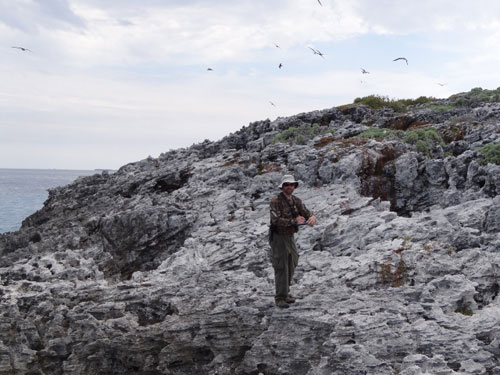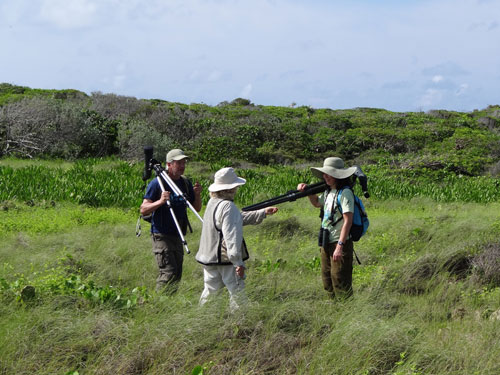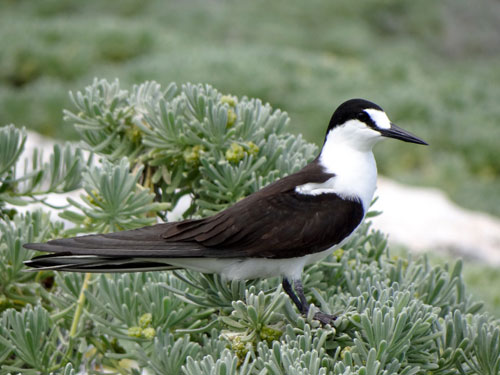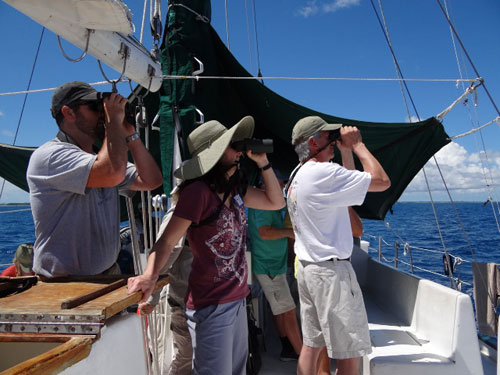
BNT teams up to asses seabirds in the Southern Bahamas.
Recently the Society for the Conservation and Study of Caribbean Birds, Biodiversity Research Institute and the Bahamas National Trust came together in a major effort to assess the seabirds of the Cay Sal Bank. The Cay Sal Bank, a remote and rarely visited island group in the south-western corner of The Bahamas archipelago, is one of the largest atolls in the world. Pictured is Dr. Will Macin counting seabirds on a cay, all work was done on a volunteer basis.
|
Recently the Society for the Conservation and Study of Caribbean
Birds, Biodiversity Research Institute (BRI) and the Bahamas National Trust
(BNT) came together in a major effort to assess the seabirds of the Cay Sal
Bank.
The Cay Sal Bank, a remote and rarely visited island group in
the southwestern corner of the Bahamas archipelago, is one of the largest
atolls in the world. Human inhabitants have established permanent settlements
on only two of the hundreds of cays and rocks on the Bank. Biodiversity
Research Institute( BRI) instituted a special Science Expedition from May 26th
– June 1, 2012 this year to allow scientists and volunteers to estimate the
number of breeding seabirds on the Cay Sal Bank.

Assessment of Seabirds in the southern Bahamas
The expedition to asses seabirds, visited three major island groups—Cotton and Anguilla Cays in the southeast corner of the Bank, the Double-Headed Shot Cays on the western side, and the Elbow Cays in the southwestern corner. At each stop, the group divided into teams, each led by an experienced field biologist. Teams set up permanent census plots to document the populations and enable monitoring of the health of the populations with future surveys. All of the fieldwork was voluntary. Pictured are Jeff Gerbracht, Cornell Lab of Ornithology, Ann Sutton, SCSCB and Lisa Sorenson, SCSCB search for wetland birds on Cotton Cay.
|
The Seabirds of the
Cay Sal Bank Expedition was BRI’s inaugural Ecotour BRI's unique new Ecotour program will allow
participants to join research biologists on scientific expeditions in locales
around the world. Groups will include a mix of experienced wildlife biologists
and interested participants
Participants lived
aboard the
Sea Explorer,
a 65-foot sailboat, chartered by Blackbeard’s Cruises, that accommodated 18
passengers in rustic, bunk-style sleep quarters. The ship’s crew provided three
meals a day plus beverages.
Working alongside Biodiversity Research Institutes wildlife
biologists and ornithologists, as well as guest biologists and conservation
experts, the expedition participants make important contributions to science
while exploring breathtakingly beautiful islands.

Caribbean Seabirds on Cay Sal Bank
Thousands of seabirds nest on the Cay Sal Bank; the area is designated as an Important Bird Area by the Bahamas National Trust and Birdlife International. The seabird colonies here have never been properly documented, however they include significant portions of the region’s seabird populations. As environmentalist strive to halt the decline of seabirds in the Caribbean, it is critical for them to know the size and status of these large populations. Pictured is a Sooty Tern on Cay Sal Bank.
|
Caribbean Seabirds
Thousands of seabirds nest on the Cay Sal Bank; the area is
designated as an Important Bird Area by the Bahamas National Trust and Birdlife
International The seabird colonies here have never been properly documented,
however they include significant portions of the region’s seabird populations.
As we strive to halt the decline of seabirds in the Caribbean, it is critical
for us to know the size and status of these large populations.
The goal of the expedition was to locate and carefully estimate
current numbers of breeding seabirds, including: Audubon’s Shearwaters, Brown
Boobies, Sooty Terns, Bridled Terns, Brown Noddies, Least Terns, Roseate Terns,
Royal Terns, and Sandwich Terns.

Sea Explorer is home for Volunteer participants.
Watching for Seabirds, participants assess the seabirds of the Cay Sal Bank. Observers lived aboard the Sea Explorer, a 65-foot sailboat, chartered by Blackbeard’s Cruises, that accommodated 18 passengers in rustic, bunk-style sleep quarters.
|
The expedition, visited three major island
groups—Cotton and Anguilla Cays in the southeast corner of the Bank, the
Double-Headed Shot Cays on the western side, and the Elbow Cays in the
southwestern corner. At each stop, the group divided into teams, each led by an
experienced field biologist. Teams set up permanent census plots to document
the populations and enable monitoring of the health of the populations with
future surveys. All of the fieldwork was voluntary.
The expedition was led by:
William A. Mackin, Ph.D., who
specializes in the conservation of Caribbean seabirds. He earned his doctorate
(UNC-Chapel Hill) studying the behavior of Audubon’s Shearwaters and other
seabirds in the Exuma Cays. In 2010, he worked in The Bahamas to determine if
oil from the Gulf of Mexico was polluting the Cay Sal Bank; that experience
inspired him to promote ecotourism to this amazing island group. For more information
on seabirds in the Caribbean visit:
http://wicbirds.net/
Lisa F. Eggert, M.S. is the director of BRI’s coastal bird program and a Ph.D.
candidate at Clemson University. Since 2010, Lisa has been leading studies of
health and movement of seabirds affected by the
DeepWater Horizon oil
spill. She and her Ph.D. advisor, Dr. Patrick Jodice, have partnered with Dr.
Mackin to track the movements and health of seabird populations in the Bahamas
since 2008.
Also participating
in the expedition were BNT Science Officer Predensa Moore and BNT Warden (Grand
Bahama) David Cleare. Volunteer
biologists and conservation professionals included Lisa Sorenson PhD and Ann
Sutton PhD of the Society for the Conservation and Study of Caribbean Birds,
Michael Sorenson PhD, Boston University, and Jeff Gerbacht Cornell Lab
Ornithology.
